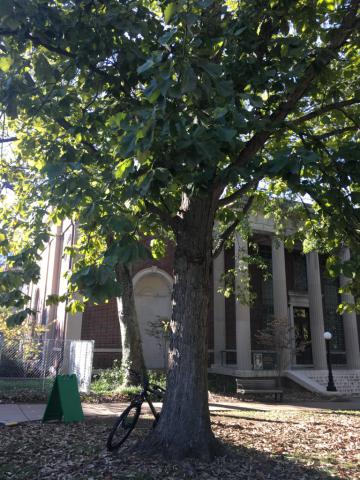
|

|

|

|
An individual instance of Quercus michauxii (swamp chestnut oak)

Permanent unique identifier for this particular organism:
http://bioimages.vanderbilt.edu/vanderbilt/15-157
Notes:
This tree is along the Esplanade, out from the southeast corner of the Cohen Building and near the sidewalk that crosses the Esplanade.
Both swamp chestnut oak and swamp white oak trees are found naturally in wetlands. They both have leaves similar to chinkapin oak: shallow rounded lobes (or large rounded teeth) and lower leaf surfaces that appear whitish and may be hairy. The primary difference in the leaves are in the number of veins. Swamp chestnut oak leaves usually have 9 or more pairs of veins that extend to the lobes, while swamp white oak leaves have 5 to 8 pairs of veins with not all extending to the tips of the lobes.
If acorns are available, the two species are fairly easily distinguished. Swamp chestnut oak acorns have short peduncles (stalks) while swamp white oak acorns have very long peduncles.
This tree is described on p. 95 of The Trees of Vanderbilt.
Both swamp chestnut oak and swamp white oak trees are found naturally in wetlands. They both have leaves similar to chinkapin oak: shallow rounded lobes (or large rounded teeth) and lower leaf surfaces that appear whitish and may be hairy. The primary difference in the leaves are in the number of veins. Swamp chestnut oak leaves usually have 9 or more pairs of veins that extend to the lobes, while swamp white oak leaves have 5 to 8 pairs of veins with not all extending to the tips of the lobes.
If acorns are available, the two species are fairly easily distinguished. Swamp chestnut oak acorns have short peduncles (stalks) while swamp white oak acorns have very long peduncles.
This tree is described on p. 95 of The Trees of Vanderbilt.

|

|
|
Load database and switch to thumbnail view
Use this stable URL to link to this page:
http://bioimages.vanderbilt.edu/vanderbilt/15-157.htm
This organism is a living specimen that is part of the Vanderbilt University Arboretum with the local identifier 1-420.
This particular organism is believed to have managed means of establishment.
This organismal entity has the scope: multicellular organism.
Remarks: Described in the 1994 Trees of Vanderbilt p. 95.
Identifications:
Quercus michauxii
Nutt.
sec. fna.org 1993
common name: swamp chestnut oak
family: Fagaceae
Identified 2002-06-13 by Steven J. Baskauf
Location:
Vanderbilt University, Nashville, Davidson County, Tennessee, US
Click on these geocoordinates to load a map showing the location: 36.14136°, -86.79897°
Coordinate uncertainty about: 10 m.
Location of individual determined from GIS database.
Occurrences were recorded for this particular organism on the following dates:
2002-06-13
2002-09-30
2014-08-27
2019-09-18
2019-10-16
The following images document this particular organism.
Click on a thumbnail to view the image and its metadata. Load database and enable navigation by taxon and organism.




















